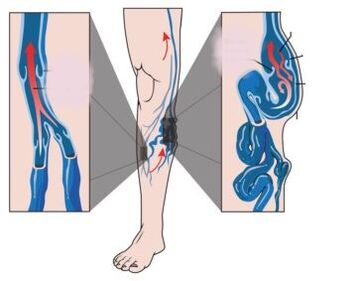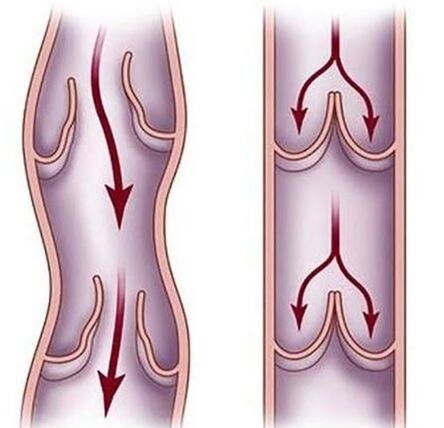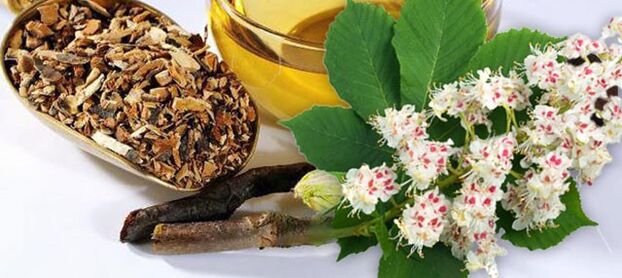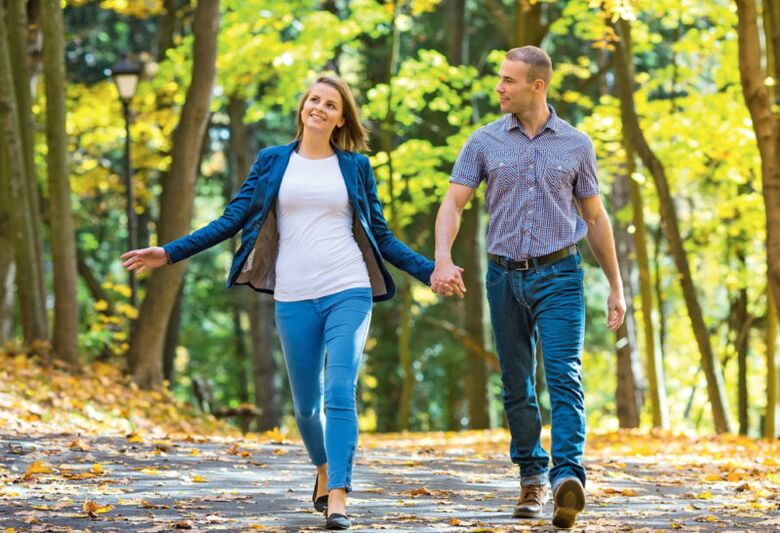Detailed description for our readers: how to cure varicose veins on the legs?on the website varicose vein-cure.rf in detail and with photos.
In the article we talk about leg veins and we talk about the treatment of varicose veins at home.You will find out which folk remedies can be used for varicose veins, whether massage is effective and in which cases surgery is necessary.Using our tips, you can make poultices and tinctures to relieve swelling and pain from varicose veins in your legs.You will also find out the list of ointments that are effective against varicose veins.
Varicose veins on the legs, veins on the legs
Varicose veins or varicose veins of the lower extremities is a disease in which the walls of superficial vessels become thinner, their lumen increases and nodular enlargements form.Externally, the disease can be detected if the veins on the legs protrude.Varicose veins occur in both women and men, but women are more susceptible to this pathology.
Causes, symptoms

Varicose veins are dilated (swollen) veins that appear on the surface of the leg muscles.Veins become swollen and tortuous and stand out strongly under the skin.Why do varicose veins occur?In the lower extremities there are saphenous and deep veins;they are connected by communicating veins.Through them, blood flows upwards from the saphenous veins to the deep ones.The muscle pump is responsible for its movement.
During physical movements, muscles contract and push blood upwards.Venous valves prevent the downward movement of blood.This is proper blood circulation, and it is possible only with normal venous tone.
If the tone of the venous wall is reduced, and the valves do not perform their function, the blood moves not only up, but also down.This increases the pressure on the blood vessels, causes them to swell and expand, and promotes the formation of knots.
Nerve endings located on the walls of blood vessels send signals to the brain.The brain gives the command to increase venous tone.The increase in resistance further increases the load on the veins, which leads to atrophy of the vein wall and death of nerve endings.
Risk factors that contribute to the appearance of varicose veins:
- sedentary lifestyle;
- lack of physical activity;
- poor nutrition;
- obesity;
- hormonal imbalance;
- pregnancy;
- genetic predisposition.
Symptoms of varicose veins on the legs:
- heaviness in legs;
- increased fatigue;
- local pain in the lower leg area;
- swelling of the legs;
- night cramps - in severe cases.
In the initial stages, varicose veins are manifested externally by the formation of spider veins on the surface of the skin.As the disease progresses, vein dilatation increases, and hemodynamics becomes more and more disturbed.In the final stages, the superficial veins merge with the skin.Veins are blocked and trophic ulcers occur.
A vein on the leg hurts - what to do?
If a bulging vein appears on the leg and it hurts, it indicates the development of varicose veins.The sooner you start treatment, the more successful it will be, and the better your chances of stopping the progression of the disease.
Which doctor should I consult for varicose veins?The diagnosis and treatment of varicose veins is carried out by a phlebologist.Even in the initial stages it is necessary to seek expert advice.He will identify the main factors that influenced the development of the disease and prescribe adequate methods of therapy and prevention.
Treatment of varicose veins on the legs
Treatment of varicose veins on the legs is carried out at home, unless the patient needs surgery or laser surgery.Doctors prescribe tablets, ointments and gels that improve venous circulation, break down blood clots, increase blood flow, relieve swelling and fatigue in the legs.Folk remedies can be used as additional therapy.
Treatment of varicose veins on the legs with folk remedies
In this part, we will tell you how and how to treat varicose veins on the legs at home.If you are interested in how to treat varicose veins on the legs in women or how to treat varicose veins in the legs in men, you will find effective folk remedies in the table.
Recipes of traditional medicine for the treatment of varicose veins:
| Title | How it works | Instructions for use |
| Nettles | It thins the blood and improves circulation, helps to strengthen the vascular walls and prevents the formation of cholesterol plaques. | Take 5 spoons.dry the nettle and pour 250 ml of vodka.Infuse the medicine for 7 days in a dark place.Use tincture 1 tbsp.3 times a day before meals. |
| Soda | It thins the blood, removes swelling and heaviness in the legs, accelerates the outflow of lymph and relieves pain. | Take 1-2 tbsp.of baking soda and lightly moisten with water.Apply the mixture to the affected area and cover with a cabbage leaf.Secure the compress with gauze and leave it overnight. You can make a foot bath with baking soda.To do this, dilute 200 g of soda in 5 liters of warm water.The duration of the procedure is 10-15 minutes. |
| Apple cider vinegar | It increases the tone of the vein walls, improves blood circulation, removes swelling and reduces pain. | Rub apple cider vinegar on the affected areas morning and night after showering. You can use apple cider vinegar as a poultice.Moisten the gauze with liquid and attach it to the leg.Lie down for 1 hour, put your feet on the pillow so that they are 15-20 cm above the level of the heart. |
| Cabbage | Relieves swelling and redness, relieves pain. | Take a cabbage leaf and press it with a rolling pin until the juice comes out.Lubricate one side of the leaf with vegetable oil and apply to the painful area.Secure the dressing with a bandage.Leave it on all day or overnight. |
| Celandine | It relieves swelling, relieves fatigue and pain in the legs. | Boil 1 tbsp.celandine in a glass of boiling water.Soak a linen cloth in the broth.Wrap your feet and leave for 1 hour.Carry out the procedure for 7 days.Then take a ten-day break. |
| Laundry soap | It relieves inflammation and accelerates regeneration processes.It promotes the healing of cracks and wounds that worsen the condition of varicose veins. | Grate a piece of laundry soap.Grind 10 aspirin tablets and pour 250 ml of vodka into them.Add soap.Leave for 2 days.Use the product as a lotion. |
| Honey | It improves blood circulation, tones the walls of blood vessels and increases their elasticity.Strengthens general and local immunity. | Take 1 tablespoon on an empty stomach.honey every day. Foot baths are made with honey.To do this, dissolve 10 g of honey in 5 liters of warm water.The duration of the procedure is 20 minutes. |
| Wormwood | It relieves inflammation, thins the blood and improves circulation, reduces pain. | Pour 2 tbsp.dry wormwood with a glass of kefir.Soak the natural fabric in the mixture.Apply the poultice to the affected area and secure.Leave for 20-30 minutes. |
| Raw potatoes | It helps to strengthen the vein walls and improve blood circulation. | Finely grate raw potatoes.Apply the paste to the feet and secure with a bandage.Leave for 5 hours. |
| Kalanchoe | Relieves inflammation, accelerates regeneration processes, removes swelling. | Wash and chop a few Kalanchoe leaves.Pour in 500 ml of vodka.Allow 7 days.Rub the prepared tincture on the painful areas of the legs. |
Ointment for varicose veins on the legs
Ointments for varicose veins are used when one or more veins are visible.Medicines for local application do not eliminate the disease, but only reduce the severity of the manifestations.If your vein is swollen and bulging, consult a phlebologist.The doctor will advise the use of ointments and gels in the early stages, but the basis for stopping the disease will be its prevention and the removal of risk factors.
List of ointments for varicose veins on the legs:
- Heparin ointment- cheap ointment based on sodium heparin.Anticoagulant not only thins the blood, but also reduces pain.
- Troxevasin— increases the tone of the vascular walls, has an anti-inflammatory, decongestive and thinning effect.It prevents the formation of blood clots.
- Medicine containing leech extract.The fat improves blood circulation, removes swelling and pain, increases the tone of blood vessel walls.
Tablets for varicose veins on the legs
In addition to ointments, tablets are also used in the early stages of varicose veins.Phlebotonics, anticoagulants, antioxidants, and antiplatelet agents are used to treat varicose veins.
Tablets for varicose veins:
- Diosmin- prevents the stretching of blood vessels, increases the elasticity of venous walls, reduces blood stagnation and helps normalize blood circulation.
- Dipyridamole— improves blood microcirculation, prevents the formation of blood clots.
In no case should you choose the medicine yourself.Tablets for the treatment of varicose veins on the legs have a large number of contraindications for use and can only be prescribed by a doctor.
How to alleviate the pain of varicose veins?For leg pain, you can use drugs with analgesic and anti-inflammatory effects - diclofenac, indomethacin, nimesulide, ibuprofen, paracetamol.To relieve fatigue, lie down for a few minutes with your legs raised above the level of your heart and a pillow under them.
Compression garments
When treating varicose veins, it is important to wear special compression clothing.Socks, knee highs, stockings and tights with different degrees of compression create the necessary pressure on the veins, this helps the muscle pump to push the blood upwards and improves blood circulation in the legs.
IN ADDITION, COMPRESSION WEARING REDUCES THE LOAD ON THE VEINS, AT THE END OF THE DAY, THE LEGS ARE LESS TIRED AND THERE IS NO SWELLING.
You should not choose a compression garment yourself, without first consulting a phlebologist.If you notice symptoms of varicose veins, consult a specialist;the doctor will examine the condition of the veins and, taking into account individual characteristics, choose the compression class and type of product.
Compression classes:
- Class 1 - compression not greater than 23 mm Hg.Art.It is prescribed in the early stages of varicose veins.
- Class 2 - compression around 33 mm Hg.Art.It is used to treat moderate varicose veins and thrombophlebitis.
- Class 3 - compression around 45 mm Hg.Art.It is used in the treatment of severe venous insufficiency.
- Class 4 - compression over 50 mm Hg.Art.It is prescribed for severe stages of the disease.
Massage for varicose veins
Massage is another method of treating varicose veins in the early stages.However, without proper technique, the procedure can cause even more damage.The massage must be performed by a qualified professional.
Is it possible to massage legs with varicose veins?
Foot massage for varicose veins can only be done in the initial stage of the disease.It is forbidden to carry out the procedure in case of trophic ulcers, thrombophlebitis and skin diseases.General contraindications are elevated body temperature, infectious diseases and inflammatory processes.Anti-cellulite massage for varicose veins should not be performed, especially with vacuum cups.
Lymphatic drainage massage is performed to treat varicose veins.It improves blood circulation and lymph drainage, removes swelling, fatigue and pain.
IN ORDER TO PERFORM A LYMPH DRAINAGE MASSAGE, FIRST WORK THE SKIN SLOWLY.THEN, WITH MAIN MOVEMENTS, PROMOTE FROM THE CALVES TO THE CALVES, GRADUALLY INCREASING THE STRENGTH OF THE PRESS.
You can also use the hydromassage with alternating water temperatures.Exposure to cold and warm water increases the tone of the vascular walls and improves blood circulation.
Laser treatment of leg veins
The procedure for treating varicose veins with a laser is called laser coagulation.This is a modern method that prevents the downward movement of blood.The laser allows you to increase the tone of the vascular walls and normalize blood circulation.
The principle of the technique is based on the thermal effect of the laser on the inner surface of the vein and blood.Steam bubbles form in the blood.Steam comes into contact with the wall of the vein, damages it and "chars".The resulting blood clot is replaced by connective tissue, and the passage is sealed.
Contraindications for laser coagulation:
- significant expansion of the venous trunk;
- foci of inflammation in the intervention area;
- thrombophilia;
- chronic ischemia of the lower extremities;
- diseases that require priority treatment.
Surgery to remove varicose veins on the legs
The disease can be cured by conservative and minimally invasive therapy, but it can be completely eliminated only by surgery.
The main surgical operation to remove varicose veins is phlebectomy.During the procedure, damaged veins are removed, which enables the normalization of blood circulation in the deep veins.
Indications:
- extensive varicose veins;
- dilated saphenous veins;
- impaired blood flow;
- trophic ulcers;
- thrombophlebitis.
Contraindications:
- late stage of varicose veins;
- cardiac ischemia;
- severe infectious diseases;
- second half of pregnancy;
- old age.
Rehabilitation after removal of leg veins
The duration of the operation is 1-2 hours.For the first time after the execution, the patient is under the supervision of a doctor.After a few hours he was allowed to move his legs.The stitches are removed after 10 days.
In the postoperative period, the patient is prescribed to wear compression stockings and perform special exercises.During the rehabilitation period, it is important to get used to normal physical activity, which will ensure blood circulation, but will not cause serious strain on the veins.
Prevention of varicose veins on the legs
Prevention plays an important role in the treatment of varicose veins.It is especially important to follow certain rules if there is a genetic predisposition and other risk factors, as well as after laser treatment and phlebectomy in order to prevent the recurrence of the disease.
To prevent varicose veins, you can use folk remedies and local remedies that increase the tone of the vein wall, improve blood circulation and relieve swelling and leg fatigue at the end of the working day.We have described all these means in the article.
Lifestyle, gymnastics and diet
To prevent the development of varicose veins, it is necessary to lead a healthy lifestyle.Give up bad habits, which include not only alcohol and smoking, but also overeating.Obesity is one of the risk factors for varicose veins.
Balance your diet, exclude fatty, fried, salty and overly spicy foods.Include more fresh fruits and vegetables in your diet.
If you want to prevent varicose veins, don't forget gymnastics and light exercises.To accelerate the blood in the lower extremities, gymnastics should use the legs.An excellent exercise for the prevention of varicose veins is cycling.
Wear comfortable shoes.If you are predisposed to the disease, consult a phlebologist.Your doctor will help you choose a compression garment.
Prevention of varicose veins during pregnancy
Pregnant women are at a higher risk of developing varicose veins.To prevent the development of the disease during pregnancy, follow simple rules of prevention:
- Wear compression socks or stockings.
- Exercise to improve blood circulation in your legs.
- Do not stand or sit in one position for a long time.
- Wear comfortable shoes and clothes.
- Sleep on your left side;this position will allow you not to pinch the vein on the right side, which is responsible for the outflow of blood from the lower extremities.
- Don't cross your legs.
- Eat right.
- Take a walk in the fresh air.
What happens if varicose veins are not treated?
Varicose veins are a serious disease that, if left untreated, can cause dangerous complications, including:
- thrombophlebitis;
- detachment of blood clot and blockage of vein lumen; pulmonary embolism;
- trophic ulcers;
- swelling of different parts of the body;
- dermatitis;
- compaction of subcutaneous fat at the site of the lesion.
What to remember
- Varicose veins are enlarged veins that occur as a result of reduced tone of the vascular wall.
- In the initial stages of varicose veins, you can use ointments and tablets as well as folk remedies.The disease can be completely cured only by surgery.
- If symptoms of varicose veins appear, consult a phlebologist.He will choose the appropriate treatment.
Varicose veins are a chronic disease in which the venous vessels are stretched or lengthened.Varicose veins do not occur only in the veins of the legs (it is the most common form), they can also develop in the blood vessels of other internal organs.For all forms of varicose veins, home treatment methods are very similar.
The diagnosis of the disease is carried out by a phlebologist or vascular surgeon, who also determines how to treat the disease in a particular case.Treatment of pathology is based on two methods: conservative treatment of varicose veins, which is carried out at home, and surgical intervention.

Varicose veins Depending on the degree of development of venous pathology, the treatment of varicose veins at home can be:
- The main treatment is only in the early stages of the disease.Seeking medical help at the stage of minor swelling of the feet or when a vascular pattern appears on the legs allows you to cure the disease at home.
- Auxiliary treatment - in advanced stages of the disease, when the developed pathology requires specialized therapy, and home exercises aimed at improving blood flow are a necessary addition to the main treatment.
- Preventive measure after surgery to prevent further development of pathology.
The basis of varicose veins is the weakness of the connective tissue of the wall of the venous vessels, therefore conservative treatment of the disease is primarily aimed at strengthening this wall.This approach to treatment is thorough and allows you to treat varicose veins of any location: both on the legs and on the veins of internal organs.
Also, the treatment of varicose veins on the legs at home requires a whole series of additional measures:
| Taking medication | Strengthening of the vascular wall |
| Taking vitamin supplements | |
| Change in diet | |
| Use of external drugs | |
| Gymnastics for the veins | Improvement of venous blood flow |
| Wearing compression garments | |
| Exercises for blood flow | |
| Sleeping with legs up | |
| Workflow optimization | Reducing the load on the leg veins |
| Losing extra pounds | |
| Special physical exercises | Strengthening calf muscles |
| Lifestyle change |
Measures aimed at strengthening the vascular wall
These methods - aimed at improving the permeability of the vascular wall of veins, increasing its tone and elasticity - are the main directions of treatment of varicose veins, including leg veins.
Includes:
- Treatment with drugs that include diosmin, troxerutin, escin.Varicose veins should be treated with these drugs only on the recommendation of a doctor, who will select the drug and determine the frequency and duration of use.
- Treatment with products according to the recipe of traditional medicine.
- Taking vitamin preparations - it has been proven that the permeability of the vascular wall is most affected by vitamins: rutin (vitamin P) and ascorbic acid.Therefore, the combination of these two vitamins is widely used for the prevention and treatment of diseases.
- Use of ointments and gels.
Recipes for folk remedies
How to treat varicose veins at home using folk remedies:

| Alcoholic tincture of horse chestnut flowers | Take 50 g of flowers, fill them with 500 ml of ethyl alcohol at a concentration of 50%.Infuse the mixture for two weeks, shake daily, then strain.Take 30-40 drops 3 times a day before meals for 30 days. |
| Infusion of nettle leaves | Take 2 tablespoons of dried nettle plant, cover with 200 ml of boiling water, leave for 1 hour.Strain the infusion, take 60 ml 3 times a day.The course of treatment is 30 days, break - 15 days, repeat twice. |
| Infusion of hop cones | Pour two tablespoons of dried pine cones with 200 ml of hot water, cook on low heat for 10 minutes, strain.Take 200 ml of infusion 2-3 times a day.Remember that it causes drowsiness. |
| Apple cider vinegar solution | Add 10 ml of apple cider vinegar to 200 ml of water, drink this drink in the morning and in the evening.The recipe is contraindicated for people with peptic ulcers of the gastrointestinal tract. |
Getting rid of varicose veins by running
Running with varicose veins is possible in the first and second stages.It is recommended to avoid significant stress on the legs, giving priority to running and jogging.In the presence of thrombosis, as well as in the later stages of the disease, running is not recommended.
Getting rid of varicose veins with the help of running is possible only at the very beginning of the disease, when the veins have not yet been stretched.At this stage, there are no clinical symptoms of the disease.Therefore, the patient simply does not know about the need to start classes.Once the diagnosis of varicose veins is made, jogging can no longer completely cure the pathology.
When to contact a phlebologist?
See a doctor about varicose veins as soon as possible.The more advanced the disease is at this point, the less likely it is that the patient will be completely cured.It is ideal if a person visits the clinic at the moment when the first signs are detected: heaviness in the legs, flying pain when standing still for a long time, swelling.
Nutrition, diet for varicose veins
With varicose veins, diet plays an important role in stabilizing the patient's condition and restoring vascular tone.
Recommended for eating:
- seafood (mussels, shrimp, squid);
- fruits rich in vitamin C (kiwi, blackcurrants, citrus fruits);
- blood thinning products (garlic, lemon, onion, cherry).
Dietary restrictions correspond to a general gentle diet.It is forbidden to take alcoholic beverages, excessively salty, hot, sour and other foods that have irritating properties.You should also not drink large amounts of coffee, tea and other drinks that have diuretic properties.
Prevention measures
The basis for the prevention of varicose veins is to abandon a sedentary lifestyle and static loads on the legs.A short run or walk of a few kilometers every day is recommended.During the working day, you should take short breaks dedicated to leg exercises.In addition, you must eat the foods described in the previous section and, if necessary, wear compression stockings.A moderate degree of compression helps improve blood flow in superficial veins.

Despite the apparent safety, varicose veins are a disease that under certain conditions poses a threat to human life.This especially applies to the later stages of the development of the pathology, in which the vascular wall becomes thinner and its integrity is easily violated.Therefore, therapy according to traditional recipes should be started as soon as possible.To avoid mistakes and using the wrong treatment methods, you should consult your doctor before you start.























